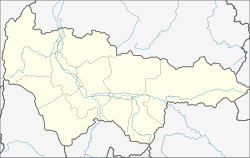Nizhnevartovsk
Nizhnevartovsk
Нижневартовск | |
|---|---|
|
From top down, left to right: lake Komsomolskoye skyline; buildings near lake Komsomolskoye; the derricks near lake Kymyl. | |
| Coordinates: 60°56′20″N 76°35′42″E / 60.93889°N 76.59500°E | |
| Country | Russia |
| Federal subject | Khanty-Mansi Autonomous Okrug[1] |
| Founded | 1909 |
| City status since | March 9, 1972 |
| Government | |
| • Body | City Duma[2] |
| • Mayor | Boris Khokhryakov |
| Area | |
| • Total | 271.319 km2 (104.757 sq mi) |
| Elevation | 45 m (148 ft) |
| Population | |
| • Total | 251,694 |
| • Rank | 73rd in 2010 |
| • Density | 930/km2 (2,400/sq mi) |
| • Subordinated to | city of okrug significance of Nizhnevartovsk[1] |
| • Capital of | Nizhnevartovsky District,[1] city of okrug significance of Nizhnevartovsk[1] |
| • Urban okrug | Nizhnevartovsk Urban Okrug[5] |
| • Capital of | Nizhnevartovsk Urban Okrug,[5] Nizhnevartovsky Municipal District[5] |
| Time zone | UTC+5 (MSK+2 |
| Postal code(s)[7] | 628600-628624 |
| Dialing code(s) | +7 3466 |
| OKTMO ID | 71875000001 |
| City Day | March 9 |
| Website | www |
Nizhnevartovsk (Russian: Нижневартовск, IPA: [nʲɪʐnʲɪˈvartəfsk]) is the second largest city in Khanty-Mansi Autonomous Okrug, Russia, located along the right bank of the Ob River. Population: 251,694 (2010 Census);[4] 239,044 (2002 Census);[8] 241,457 (1989 Soviet census).[9]
Geography
The city is laid out on a grid system; however, due to its location on the bank of the river, there is a central kink in the grid which parallels the river's course.
Climate
Each winter, temperatures can drop as low as −50 °C (−58 °F), and the local residents build a number of ice parks with snow and ice sculptures and play areas for children, mostly comprising images of Father Frost (Russian Santa), and ice slides. In the summer, temperatures can reach as high as +35 °C (95 °F).
History
It was founded in 1909; its development into a large city was boosted in the 1960s by the discovery of the Samotlor Oil Field, the largest in the country.[citation needed] Town status was granted to it on March 9, 1972.[citation needed]
Administrative and municipal status
Within the framework of administrative divisions, Nizhnevartovsk serves as the administrative center of Nizhnevartovsky District, even though it is not a part of it.[1] As an administrative division, it is incorporated separately as the city of okrug significance of Nizhnevartovsk—an administrative unit with the status equal to that of the districts.[1] As a municipal division, the city of okrug significance of Nizhnevartovsk is incorporated as Nizhnevartovsk Urban Okrug.[5]
Economy
Nizhnevartovsk is the center of the West Siberian oil-producing region and one of the wealthiest cities in the country. The Nizhnevartovsk Airport is the fifteenth busiest airport in Russia, well ahead of those in many larger cities.[citation needed]
International relations
Twin towns and sister cities
Nizhnevartovsk is twinned with:
References
Notes
- ^ a b c d e f g Law #43-oz
- ^ [1]
- ^ Социальный паспорт города Нижневартовска по состоянию на 01.01.2012 года. Официальный сайт органов местного самоуправления города Нижневартовска
- ^ a b Russian Federal State Statistics Service (2011). Всероссийская перепись населения 2010 года. Том 1 [2010 All-Russian Population Census, vol. 1]. Всероссийская перепись населения 2010 года [2010 All-Russia Population Census] (in Russian). Federal State Statistics Service.
- ^ a b c d Law #63-oz
- ^ "Об исчислении времени". Официальный интернет-портал правовой информации (in Russian). June 3, 2011. Retrieved January 19, 2019.
- ^ Почта России. Информационно-вычислительный центр ОАСУ РПО. (Russian Post). Поиск объектов почтовой связи (Postal Objects Search) (in Russian)
- ^ Federal State Statistics Service (May 21, 2004). Численность населения России, субъектов Российской Федерации в составе федеральных округов, районов, городских поселений, сельских населённых пунктов – районных центров и сельских населённых пунктов с населением 3 тысячи и более человек [Population of Russia, Its Federal Districts, Federal Subjects, Districts, Urban Localities, Rural Localities—Administrative Centers, and Rural Localities with Population of Over 3,000] (XLS). Всероссийская перепись населения 2002 года [All-Russia Population Census of 2002] (in Russian).
- ^ Всесоюзная перепись населения 1989 г. Численность наличного населения союзных и автономных республик, автономных областей и округов, краёв, областей, районов, городских поселений и сёл-райцентров [All Union Population Census of 1989: Present Population of Union and Autonomous Republics, Autonomous Oblasts and Okrugs, Krais, Oblasts, Districts, Urban Settlements, and Villages Serving as District Administrative Centers]. Всесоюзная перепись населения 1989 года [All-Union Population Census of 1989] (in Russian). Институт демографии Национального исследовательского университета: Высшая школа экономики [Institute of Demography at the National Research University: Higher School of Economics]. 1989 – via Demoscope Weekly.
Sources
- Дума Ханты-Мансийского автономного округа — Югры. Закон №43-оз от 7 июля 2004 г. «Об административно-территориальном устройстве Ханты-Мансийского автономного округа — Югры и порядке его изменения», в ред. Закона №129-оз от 9 декабря 2015 г. «Об изменениях административно-территориального устройства Ханты-Мансийского автономного округа — Югры и о внесении изменений в отдельные Законы Ханты-Мансийского автономного округа — Югры». Вступил в силу по истечении десяти дней со дня официального опубликования. Опубликован: "Новости Югры", №83, 17 июля 2004 г. (Duma of Khanty-Mansi Autonomous Okrug—Yugra. Law #43-oz of July 7, 2004 On the Administrative-Territorial Structure of Khanty-Mansi Autonomous Okrug—Yugra and on the Procedures for Its Change, as amended by the Law #129-oz of December 9, 2015 On the Changes to the Administrative-Territorial Structure of Khanty-Mansi Autonomous Okrug—Yugra and on Amending Various Laws of Khanty-Mansi Autonomous Okrug—Yugra. Effective as of the day which after ten days after the official publication date.).
- Дума Ханты-Мансийского автономного округа — Югры. Закон №63-оз от 25 ноября 2004 г. «О статусе и границах муниципальных образований Ханты-Мансийского автономного округа — Югры», в ред. Закона №129-оз от 9 декабря 2015 г. «Об изменениях административно-территориального устройства Ханты-Мансийского автономного округа — Югры и о внесении изменений в отдельные Законы Ханты-Мансийского автономного округа — Югры». Вступил в силу по истечении десяти дней со дня официального опубликования и до 1 января 2006 года применяется в целях реализации статей 84, 85 Федерального закона от 06.10.2003 №131-ФЗ. Опубликован: "Новости Югры", №143, 7 декабря 2004 г. (Duma of Khanty-Mansi Autonomous Okrug—Yugra. Law #63-oz of November 25, 2004 On the Status and Borders of the Municipal Formations of Khanty-Mansi Autonomous Okrug—Yugra, as amended by the Law #129-oz of December 9, 2015 On the Changes to the Administrative-Territorial Structure of Khanty-Mansi Autonomous Okrug—Yugra and on Amending Various Laws of Khanty-Mansi Autonomous Okrug—Yugra. Effective as of the day which after ten days after the official publication date; also in effect until January 1, 2006 in order to meet the requirements of Articles 84, 85 of the Federal Law #131-FZ of October 6, 2003.).
External links
- Official website of the Nizhnevartovsk City Administration Template:Ru icon
- Information portal of Nizhnevartovsk Template:Ru icon
- Mojgorod.ru. Entry on Nizhnevartovsk Template:Ru icon
- Nizhnevartovsk Airport
- Nizhnevartovsk Web cam
- Nizhnevartovsk info portal









